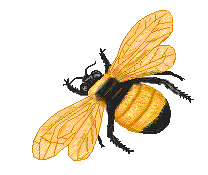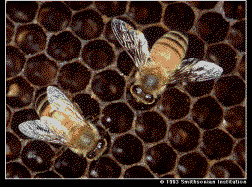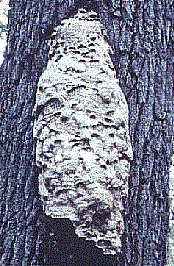Services
Bee Stings
|
|
|
|---|
|
Services Bee Stings |
Bees and Wasps |
|---|

|
There are about 19,000 known species of bee, a similar
number of species of wasps and a good many more of each that we have
yet to discover and catalogue.
Many of these insects are solitary in habit, but some of them are social and live in colonies varying in size from a few dozen up to many thousands. All in all, we humans are outnumbered by bees on this planet by an estimated 20,000 to 1. There are also many thousands of other insects that are equipped with stings, yet incidence of any insect stinging a human being are very rare. Bees are in fact very gentle creatures if left undisturbed. |
|---|

|
These are the bees that beekeepers keep in hives, they
pollinate most of our crops and help to keep the cost of food
production down. They produce honey and beeswax and have been
unchanged for something like 50 million years. I find them
fascinating and I have been passionately fond of them for most of my
life.
These are the only type of bee which forms a swarm. Unfortunately owing to poor understanding and a general lack of knowledge, this tends to frighten people. If you find a swarm, contact a local beekeeper and he or she will tell you what to do about it. You should not be alarmed, it is a natural process that helps the bees to find a new home. |
|---|

|
The bumble bee nest could be one of two types either like a
grapefruit although more orange in colour or the other version which
is more like an enclosed bird's nest. You may find them nesting in
loose earth or a bird nesting box, under a compost heap, or underneath
a garden shed, especially if a mouse might have previously nested
there.
The nests of bumble bees will be empty by October/November and may then be removed without fear of being stung. If you remove such a nest place the remains in a polythene bag and seal it, then put it in the dustbin do not be tempted to put it on the compost heap unless you desire to have a dozen or so nests next year. |
|---|

| Are much disliked, but if the truth be told they have no greater propensity to sting than a bee does. Their nests are made from paper that they prepare by chewing fibres from old wood. Wasps are actually quite beneficial to gardeners as each wasp nest will consume about 110,000 caterpillars and grubs during the early part of the season. |
|---|
Hornets
The picture on the right shows a large hornets nest bulging from a hole in a tree trunk. |

|
|---|
Originated... Summer 2000, Revised... 10 October 2001, Revised... 22 September 2003, New Domain... 17 June 2004, Upgraded... 29 August 2004, Revised 30-11-11, |